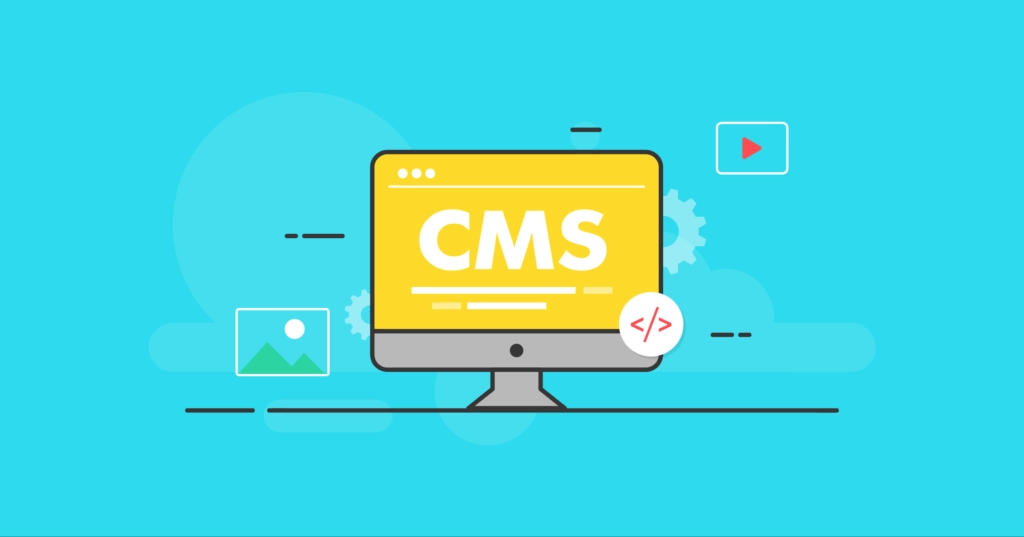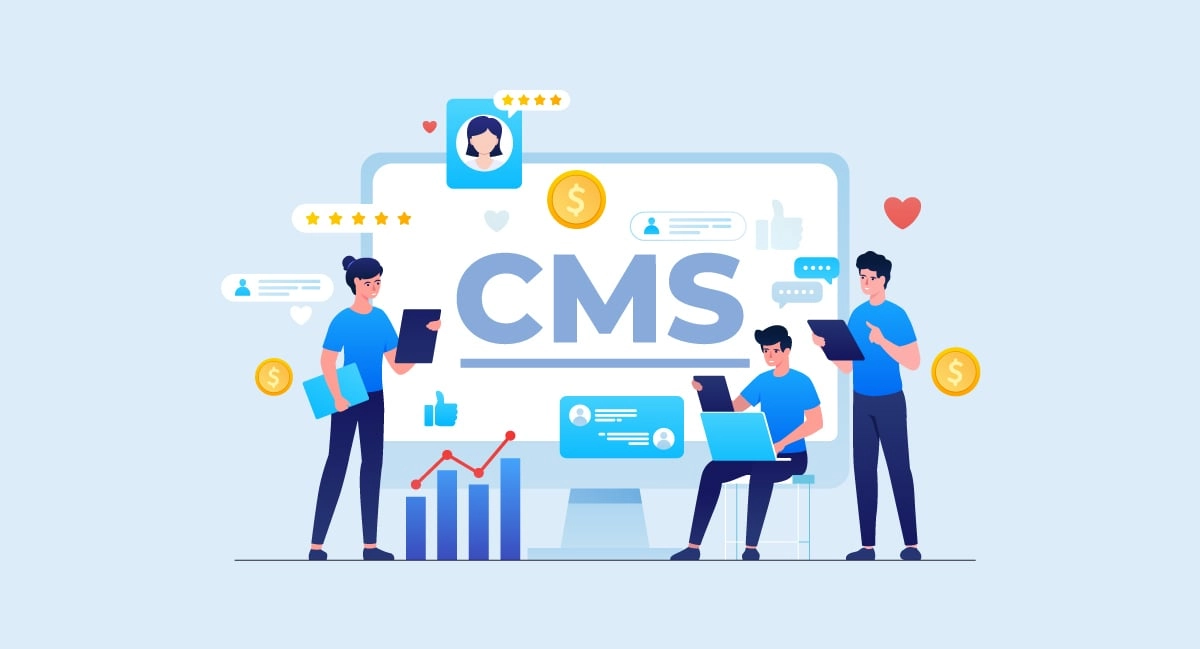
A content management system, in such cases, is an immensely beneficial and effective tool to ensure consistency and organize big chunks of content under one roof. Fasten your seatbelts as we dive in to discover what a content management system is, the key features, and the types of systems to know about.
What Is a Content Management System
Content management systems (CMS) are tools that make it easier to create, manage, monitor, and store digital assets. This is known as content management. These tools offer the convenience of having a better grip on your content, regardless of how large the inventory is and the diversity of platforms where the content will be published.
How a Content Management System Works
A content management system is extensive and often contains a plethora of themes, layouts, and formats to work with. These systems (tools or software solutions in most cases) offer a user-friendly interface that is easy to interact with. As most of these tools do not require extensive coding skills or knowledge, they can be used by anyone.
Once the content has been updated successfully on the CMS after login, it can be organized into different categories or subcategories depending on whether they will be published in the data. Images, videos, and texts can be stored in the database, making it easier for businesses dealing with different content formats to store data.
The content is stored in a highly structured layout, making it easy for website owners to publish content in a systematic manner. Upon publishing the content, it can be managed by the backend by adding new information, removing outdated content, or even updating links. Periodically reviewing, managing, and updating the content is vital to keeping your business updated with the latest market trends.
The Benefits of Using a Content Management System

The advantages of using a content management system are expansive, regardless of whether a small or big business is using the tool. Here are some of them that make this tool such a worthy investment:
- User-friendly: Most CMSs are built to be intuitive and easy to use, allowing people with minimal or no technical knowledge to use them seamlessly. Due to this, there are no additional costs or requirements involved with training your team to become familiar with the tool.
- Cost-effective: CMSs combine a plethora of features under one unit, allowing a business to use multiple features without paying additional fees for them.
- Versatile and flexible: The range of customization options is endless, allowing businesses to create and maintain content pieces in accordance with their needs.
- Time-saving: CMSs offer the convenience of automation, allowing businesses to save time spent on repetitive tasks. The saved time can be spent on creating content or other meaningful tasks.
- Scalable: As your business grows, the tool’s ability to assist with managing additional tasks becomes easier by merely making a few technical upgrades.
- Seamless collaboration: Whether you have a large team working to maintain a website or multiple departments sharing the workload, CMSs facilitate extended collaboration without hassles.
- Security features: A content management system’s range of security features is marvelous. They protect data from theft, back up content, offer role-based access, and provide robust encryption.
- Integrations: The range of integrations that a CMS offers can be customized to meet the unique needs and requirements of a business. So, whether you want to send a recently published blog as an email to your subscribers or want to automate a comment-filtering extension, the possibilities become truly endless.
- SEO-friendly features: Search engine optimization is crucial today to make your website more relevant. Most CMSs either have a built-in SEO feature or have plug-in or extension options to make it easier for businesses to optimize their content for improved ranking.
Note: The range of benefits a business can experience with a content management system depends extensively on the range of features they are using. Make sure to check customization options with your current CMS to see the availability of features.
Key Features of a Content Management System
Over the years, content management systems have gained immense popularity due to the range of features they offer. Here are some of the features that make them such a top choice for many businesses aiming to create a strong online presence:
-
Engaging Dashboard
A CMS dashboard is at the very core of its functionality and, thus, is an incredibly important factor to consider. As the tool will be used on a frequent basis for content production, reviewing, publishing, and updates, it is essential that the dashboard is intuitive to make the process seamless and less repetitive. This is particularly required for tasks like tracking spam comments, preventing hacking attempts, and performing analytics.
-
Responsive Platform
When choosing a CMS platform for your business, checking the range of themes is recommended. The website’s theme is the skeletal structure that binds everything together, and a CMS offering different themes is essential to ensure consistency throughout the website in terms of look and feel. There’s a chance you may have to download or purchase themes or additional plugins, but it will be worth it in the long run.
-
Content Backups
Your CMS tool should be able to track and record the changes being made to your content. Aside from this, it is also essential the tool ensures a seamless publishing process. It is essential to check if the CMS tool you are using offers the convenience of backup.
At the same time, make sure to check if these backups are to be done manually or can be automated before making any significant changes. So, if you have to revert these changes, you have a backup in hand.
Your website hosting platform will also offer a backup feature. Be sure to explore them to create an additional layer of content backup.
-
Immense Publishing Controls
Whether you want to publish your content right away or are waiting for your team to review it for any editing potential, your CMS tool must abide by your requirements. Another aspect worth considering is the extent of control individual team members have when using the CMS tool. For instance, writers can only write, editors can only make edits, and developers add visual content pieces and then proceed to publish content.
Such control prevents chances of data breaches and also ensures that only required changes are being made to the content. This is especially important if your business works with freelancers. You wouldn’t want them to publish the content without your team of editors and developers aligning the content pieces to your brand’s standards. At the same time, make sure the controls are not overly stringent, as it can make collaboration a challenge to accomplish.
-
Extensive Integrations
Content management systems are versatile, and what makes them so flexible is the range of integrations they offer. Be it analytical tools, marketing and customer insights, and even AI integrations, it is essential that your CMS is compatible.
As the technology evolves, staying in sync with the updates is crucial to ensure your business stays relevant and in demand. Avoid adding too many integrations or plugins to your website, as they can significantly slow down the website’s loading speed, ultimately hampering the user experience (a crucial ranking factor).
-
Detailed Analytics
With constantly changing consumer demands, keeping an eye on analytics can be pivotal to updating your strategies well ahead of time. This is particularly crucial for businesses in a dynamic market where products or services can go obsolete if the demand changes rapidly. Due to this, your CMS tools must offer the convenience of data analytics.
Some effective metrics to track with a CMS tool include:
- Average session duration
- Average time on page
- Bounce rate
- Conversion rate
- Event tracking
- Exit rate
- New visitor sessions
- Page views
- Pages per session
- Returning visitor sessions
- Revenue attribution
- Social referrals
- Top exit pages
- Top pages
- Traffic sources
These metrics are important to track the results that your business’s digital content is performing.
-
SEO Tools
Search engine optimization ensures your web content has been optimized to rank higher on search engines. This is done with the purpose of increasing brand awareness and discoverability and eventually generating revenue for your business.
To ensure you do not have to worry about SEO with your CMS, here are the best CMS platforms to consider:
- WordPress
- Magento
- Wix
- Adobe Experience Manager
- Shopify
- Joomla
- Hubspot CMS
These are the most popular CMS tools that are often used by businesses to have 360° control of their content. Be it from the stage of creation to publishing and even monitoring. Make sure you are thoroughly checking the features and pricing plan before making a commitment.
-
Easier and Safer Migrations
Whether you are creating your website from scratch on a CMS or uploading large data to the server, the content management system must have features that facilitate the process. Some CMS platforms even offer the convenient feature of safe migration if you are moving from one CMS to another.
At the same time, you are also advised to check how you can move content out of the management system if you want to move to a more scalable option. Being able to upload or retrieve data without compromising on safety is an essential feature to look for in CMS.
How To Choose the Best Content Management System
The content management system or CMS will be a vital component of how your business organizes, manages, monitors, and publishes content. Being picky on grounds of the technical expertise of your team, the extent of the tool’s requirements, and areas of application are a must.

Here are some practical factors to consider when opting for a CMS:
- The tool offers a range of functions in terms of content creation and management.
- Security features as a growing website are often under cybersecurity threats.
- The frequency at which the security features are updated.
- Customization options in terms of how your website looks and feels.
- The tool’s ability to integrate with other tools like marketing and advertising or data analytics tools.
- The extent of support available from the CMS platforms and the presence of consistently updated resources.
- The overall cost of implementing the tool in your organization.
How To Measure the Success of Your Content Management System

A CMS, indeed, is a powerful tool, but monitoring the effectiveness of these systems ensures they are aligning with your business objectives. That said, not knowing what to measure can often lead to inconclusive results.
Here are some key metrics to track to determine your CMS’s success:
-
Page Load Speed
The page load speed indicates the time it takes for a webpage to load once the user has landed on it completely. It is a crucial ranking factor, which, if not met, can result in a lower ranking on SERPs. Google Search Console integration can be immensely helpful in identifying the maximum time taken for the Largest Contentful Paint (LCP) to load, creating scope for significant improvement.
-
Content Delivery Network (CDN) Performance Metrics
Monitoring this metric is important to ensure content is served to the user quickly, regardless of their location. Tracking parameters like latency, geographical performance, error rate, cache hit ratio, and throughput are some parameters to track.
-
SEO Parameters
Amongst the many reasons for using a CMS, the primary one is being able to rank higher on SERP. Checking SEO parameters like search visibility, organic conversions, keyword rankings, organic traffic, and backlink quality will give constructive insights into how your CMS is pairing with your SEO efforts.
-
Rate of Content Production
This parameter is concerned with the rate at which the content moves from ideation to creation to publishing rate. An efficient content production rate ensures there’s content being published regularly. It ensures user engagement and consistently drives results to your website.
-
User Engagement Metrics
When your business is consistently focusing on publishing high-quality and valuable content, tracking user engagement is of paramount importance. It shows how your content is being perceived by your target audience and their reactions. Tracking parameters like content views, time on page, interaction rate, and bounce rate will reveal insightful details about your target audience. It will also enable your business to create content that caters to their needs.
-
Return on Investment
Your CMS must help achieve your ROI goals. Measuring it ensures you are constantly keeping an eye on your growth while improving critical touchpoints on the way. Make sure you are constantly evaluating how your top-performing content is driving results and measures you can take to create more such pieces.
Bottomline
Content management systems are versatile and an important tool to make your business appear authoritative, approachable, and worthy of investment. From choosing the right tool to start your content management process to deeply analyzing your target audience’s response to your content, there’s a lot that these tools can help with. Be sure to opt for the tool that matches your business’s specific requirements, technical skills, and the extent to which the tool will be used.







